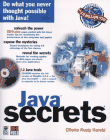
Each book begins with a chapter about what's special about Java and how it differs from other programming languages. Each book shows how to write Hello World and other command line applications to teach Java's syntax. There is a chapter or two on object-oriented programming, a chapter on threads, a chapter on exceptions, and a few chapters on the AWT. I know. I wrote one of these books.
Java Secrets is different. It starts where the other books stop. This book assumes you already know Java's syntax and what an object is. This book assumes you're comfortable with the AWT. Instead of rehashing these topics, this book delves into the parts of Java that are not documented by Sun, that are not generally accessible to anyone with a web browser, and that are not already in a hundred other books.
I had some reservations about writing this book. I still do. This is a dangerous book. It reveals knowledge that can easily be abused. Improper use of the secrets revealed herein can easily tie Java programs to specific platforms or implementations. As a longtime Mac user I know the agony of watching all the best software come out on Windows first and the Mac much later, if at all. I do not want to extend this trend to Java-based software.
Nonetheless I have come to the conclusion that a book like this is necessary if Java is to move out of its niche of creating applets for web pages and into the broader software development market. There are many applications for which Java is ideal, but which cannot be written without more information than Sun has chosen to reveal. Among other things these include stand-alone executable applications. HotJava and javac are such applications so it must be possible to write them, but until now Sun has not revealed how. This book reveals that secret among others.
However, rationalize though I might (and I'm quite good at rationalizing, I admit), the real reason this book is being written is that it seemed like a neat thing to do at the time. This is far and away the most exciting book I've ever written. The sheer number of "Aha!" experiences I've had while researching and writing it is phenomenal. I hope you'll get the same feeling while reading it. Nonetheless, I know the information I present here will be misused. I accept that. Nonetheless I firmly believe that in the long run more knowledge is a good thing, dangerous though it may be; and that secrets are meant to be revealed.
After a brief introduction, Part One begins with six chapters on Java internals. The reader will learn how objects and primitive data types are laid out in memory, how arguments are passed to and values returned from methods, what a variable really is, and more. Java's implementation of arrays and Strings will be explored. Different possible models for threads and algorithms for garbage collection are discussed and compared, shedding some light on why Java uses the data structures and algorithms it does and why it sometimes behaves in unexpected ways. This is all tied to the Java .class file format in two chapters that teach the reader how to read and disassemble Java byte code. You'll learn some details about Java's thread model and garbage collection algorithms. Finally you'll learn how an applet runs and what really happens when a web browser loads an applet.
Part Two delves into the sun classes, a group of undocumented packages that add considerable power to Java programs. The following are just a few of the undocumented classes that will be covered in this section:
Part Three explores the possibilities opened by platform dependent code. It demonstrates how to call the native API and how to create stand-alone executable programs.
This is not an introductory book. It is for the programmer who has learned enough about Java to be frustrated by its limitations. You should have a solid grasp of the fundamentals of both the Java language and the AWT, including advanced topics like threads. Although every effort has been made to make this book accessible to as broad a range of readers as possible, this is not an introductory book and does require more of its reader than most books on the market.
On the other hand this book does not assume prior experience with assembly language, Java byte code, compiler design, or even pointers. In fact this book may serve as a first taste of some of these to a reader who's never seen them before, in Java or any other language. Nonetheless low-level programmers who are familiar with pointers, assembly language and compiler design should nonetheless find the discussion of Java's implementation of these topics to be useful. They'll simply find the book easier going than a programmer encountering these topics for the first time.
I am certain there are mistakes here. In fact, I'm sure there are some real whoppers. (The first one's on the back cover. Somehow the system requirements were mistakenly listed as Windows 95 and Office 97. That's totally untrue. Any Java 1.0 or later platform should be fine. The book was mostly written on a Macintosh powerBook and a Solaris SparcStation. The screen shots are mostly from the Mac.) Please, please use this information carefully and read it with a critical eye. If you do find mistakes or inaccuracies, let me know by sending email to elharo@sunsite.unc.edu, and I'll correct them in future editions. I will also post corrections and updates on my web site at http://sunsite.unc.edu/javafaq/secrets/ so you may wish to look there first before sending me email.